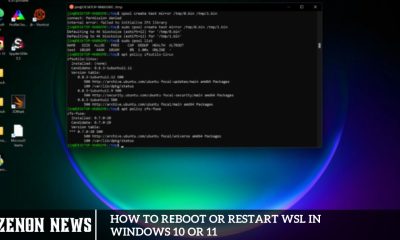News
Russia Looking To Invest In Developing In-House Gaming Console

Under President Vladimir Putin’s direction, the Russian government is undertaking an initiative to explore the development of domestic gaming consoles, potentially to rival established brands like PlayStation and Xbox within the Russian market.
Following a conference in late January focusing on the socioeconomic development of the Kaliningrad area, President Putin has authorized a series of nine orders to be pursued. One notable directive is creating a comprehensive digital entertainment platform reminiscent of Valve’s recent offerings.
This endeavor is significant as it aligns with Russia’s broader aim of fostering a self-sufficient ecosystem of domestic producers across various industries, ensuring its competitive edge remains unchallenged.
Understanding Russia’s Vision
Russia’s decision to invest in developing an in-house gaming console stems from its vision to enhance technological sovereignty and reduce dependence on imports. With a focus on bolstering its domestic technology sector, the Russian government aims to nurture homegrown talent and innovation while fostering economic growth.
In addition, President Putin has greenlit plans to establish a dedicated cloud infrastructure and operating system tailored for these consoles. Responsibility for executing these plans has been entrusted to the prime minister of Russia, with a deadline set for June 15, 2024. A Kremlin spokesperson confirmed that these directives aim to bolster Russia’s domestic gaming market.
Kommersant, a Russian-language newspaper, has investigated the feasibility of this initiative and consulted with local developers. Their analysis suggests that developing a gaming system from scratch could take five to ten years. However, despite these efforts, the resulting technology may lag behind existing systems by approximately fifteen years.
The Growing Importance of the Gaming Industry
The global gaming industry has witnessed exponential growth in recent years, emerging as a multi-billion-dollar market with a diverse consumer base. Recognizing the economic potential and cultural significance of gaming, Russia seeks to tap into this lucrative industry by introducing its gaming console.
An ambitious endeavor
Gaming technology has been on the Russian government’s radar for some time. In 2022, discussions began within the Ministry of Digital Development regarding the potential development of a native Russian game engine. However, venturing into creating an entire gaming platform from scratch presents an even more formidable challenge.
Admittedly, today’s landscape for constructing a game console is more favorable than in previous eras. Leveraging open-source platforms such as Android can offer a solid foundation for crafting a tailored gaming operating system (as seen with Ouya, to some extent). Additionally, readily available system-on-a-chip solutions can streamline hardware engineering and bring a new console to life.
Yet, even with these potential solutions in place, the Russian government would still need to construct the framework to support a comprehensive gaming platform. Establishing features like payment processing, game downloads, online multiplayer capabilities, moderation tools, quality assurance measures, and more presents a complex challenge, even for industry giants like Microsoft or Valve. Furthermore, the considerable task is attracting developers to create content for this emerging platform.
The Roadmap to Developing an In-House Gaming Console
Russia’s journey towards creating an in-house gaming console involves a strategic roadmap encompassing research, development, and collaboration with industry experts. Leveraging its pool of skilled engineers and scientists, Russia aims to design a cutting-edge gaming platform that rivals existing consoles in terms of performance and innovation.
Potential Challenges and Opportunities
While Russia’s venture into the gaming console market presents numerous opportunities, it also faces several challenges. These include technological barriers, competition from established players, and the need for a robust ecosystem of developers and gamers. However, with proper planning and investment, these challenges can be overcome, paving the way for a thriving gaming industry in Russia.
Russia Developing Indigenous Lineup of Gaming Consoles
President Putin has directed government officials to explore the production of domestically manufactured consoles, encompassing both stationary and portable devices. A spokesperson for the Russian government has affirmed Russia’s commitment to fostering its domestic gaming industry.
Earlier in 2024, the Russian Video Game Industry (RVI) expressed its aim to enhance relations with various international gaming organizations associated with Russia and establish a foundation for developing domestic games in the future. This initiative echoes similar strategies outlined in recent years, such as Russia’s 2022 announcement of plans to create a competitor to the Unreal Engine. While the outcome of these latest directives remains uncertain, further updates may be forthcoming later this year.
The Russian government’s tensions with the Western gaming industry extend beyond developers. In 2023, a Russian court imposed fines on Twitch for disseminating false information. This ruling stemmed from Twitch’s refusal to remove content related to Russia’s incursion into Ukraine, specifically concerning civilian casualties and the tactics employed by the Russian military.
Competing with established console manufacturers like Sony and Microsoft presents a formidable challenge for the Russian government. Both companies are forging ahead with their next generation of consoles, exemplified by the recent leak of Microsoft’s forthcoming Xbox Series X model. However, past sanctions have led Microsoft and Sony to restrict the sale of their products in Russia. Should these sanctions persist, the viability of a domestic console becomes more feasible in the long term.
Implications for the Global Gaming Market
The emergence of Russia’s in-house gaming console could disrupt the global gaming market, introducing a new player with unique offerings and capabilities. As competition intensifies, established console manufacturers may need to innovate further to maintain their market share, benefiting consumers through enhanced gaming experiences and technological advancements.
Frequently Ask Questions
What is Russia’s motivation behind investing in developing an in-house gaming console?
Russia aims to enhance its technological sovereignty and reduce import dependence by fostering domestic innovation and talent. Developing an in-house gaming console aligns with Russia’s vision of bolstering its domestic technology sector and stimulating economic growth.
How does Russia plan to compete with established players in the gaming console market?
Russia plans to leverage its pool of skilled engineers and scientists to design a cutting-edge gaming platform that rivals existing consoles in performance and innovation. Additionally, strategic collaborations with industry experts and establishing a robust ecosystem of developers and gamers are key components of Russia’s competitive strategy.
What are some potential challenges Russia may face in developing an in-house gaming console?
Some potential challenges include technological barriers, competition from established players, and the need to develop a strong developer and gamer community. Additionally, ensuring compatibility with existing gaming libraries and overcoming potential regulatory hurdles may pose challenges.
How will Russia’s entry into the gaming console market impact the global gaming industry?
Russia’s entry into the gaming console market could disrupt the global gaming industry by introducing a new player with unique offerings and capabilities. This could stimulate further innovation among established console manufacturers and benefit consumers through enhanced gaming experiences and technological advancements.
What are the potential benefits of Russia’s investment in developing an in-house gaming console?
Some potential benefits include fostering domestic innovation and talent, reducing dependence on imports, stimulating economic growth, and asserting Russia’s technological prowess on the world stage. Additionally, the project could create new job opportunities and contribute to developing a vibrant gaming ecosystem within Russia.
How will Russia ensure the success of its in-house gaming console project?
Russia plans to ensure the success of its in-house gaming console project through careful planning, strategic investment, and collaboration with industry experts. Russia aims to create a competitive gaming platform that resonates with domestic and global audiences by leveraging its technological expertise and fostering a supportive ecosystem of developers and gamers.
Conclusion
Russia’s endeavor to develop an in-house gaming console signifies its ambition to assert itself as a major player in the global tech industry. By investing in innovation and fostering homegrown talent, Russia aims to carve out a niche in the competitive gaming market while bolstering its technological prowess on the world stage. As the project unfolds, the world eagerly awaits Russia’s rise in the gaming realm.
In summary, Russia’s decision to invest in developing an in-house gaming console marks a significant step towards technological sovereignty and economic diversification. With careful planning and execution, Russia has the potential to become a formidable player in the global gaming market, shaping the future of gaming technology for years to come.
News
Binary Option Is It Safe? Answer

Introduction
Binary options are a financial instrument that allows traders to bet on the direction of a certain asset’s price movement for a fixed amount of time. Despite their attractiveness because of their simplicity and the possibility of making quick money, they involve high risks.
What are Binary Options?
Binary options (or “digital options”) offer two possible outcomes: the trader either makes a fixed profit or loses his bet. This allows you to know in advance the amount of possible profit and loss. Among the advantages of binary options:
- Trading binary options does not require in-depth knowledge of financial markets or complex strategies. You only need to predict whether the price will be higher or lower than the current price.
- The opportunity to make money in the shortest possible time.
- Binary options often have expiration dates of a few minutes.
- The trader knows how much he or she can lose or make even before making a trade. This helps to manage risk more effectively.
- Many options brokers are ready to offer convenient and functional trading terminals, such as the author’s terminal Pocket Option – a reliable broker that has earned the trust of traders.
Binary Options Risks
Binary options are considered a high-risk instrument because price fluctuations on short time intervals can be unpredictable. In some countries, binary options are almost unregulated, which creates a favorable environment for fraudsters and unscrupulous brokers. Without proper analysis and strategy, trading binary options can become a game of chance, where the outcome of trades depends more on luck than on the trader’s skill.
Scams and Unscrupulous Brokers
Fraud in the binary options industry is common. Often scammers create fake platforms that do not pay out winnings or manipulate prices. Here are a few signs to look out for:
- Hidden terms of bonuses and promotions.
- Broker may delay or refuse to withdraw funds.
- Dishonest brokers may change asset prices in their favor.
- Too many negative reviews about the broker on the web.
Precautions
- Choosing a reliable broker
Check for licensing and regulation. Reliable regulators: FCA (UK), CySEC (Cyprus), ASIC (Australia), etc. Read reviews from real users and check broker ratings on independent platforms.
One of the top and reliable brokers today is Pocket Option, on whose website you can study its license, see its terminal, trading conditions, withdrawal conditions and contact support. All this shows that such a broker can be trusted.
- Training and practice
Take courses on binary options trading. Use the broker’s demo account to practice without the risk of losses.
- Strategy development
Study different trading strategies and choose the one that suits you. Apply technical and fundamental analysis to make informed decisions.
- Risk Control
Determine how much capital you are willing to risk in each trade. Use risk management strategies, such as setting stop losses and take profits.
- Explore the market
Learn the basics of how financial markets work and the different types of assets you can work with. Study the macroeconomic factors that can affect asset prices.
- Be careful with bonuses
Some brokers offer deposit bonuses, but they may come with complicated withdrawal terms. Therefore, read the terms and conditions of bonuses and promotions carefully.
- Keep an eye on the news
Economic events and news can have a significant impact on asset prices. Use economic calendars and keep an eye on major events that can affect your trading.

Conclusion
Binary options offer the opportunity to make quick money, but they also come with high risks. Success in binary options trading requires education, experience and discipline. Choose your broker carefully, continually educate yourself and develop strategies to minimize risk and increase your chances of success. Always remember that investing in financial instruments, including binary options, can lead to losses, so invest responsibly and only invest what you are willing to lose.
News
White Hair and Natural Prevention Methods – Wellhealthorganic.com

Have you started noticing white strands among your once-pigmented hair? You might be wondering what’s causing this change and how to prevent it. Don’t worry; you’re in the right place! Welcome to WellHealthOrganic’s guide on understanding the causes of white hair and exploring natural prevention methods.
Imagine this scenario: you’re preparing for a special event, and a silver strand catches your eye as you glance in the mirror. While some embrace the wisdom that comes with gray hair, others may wish to preserve their youthful appearance a little longer. Regardless of your perspective, we’re here to explore the science behind this change and provide natural, practical strategies to maintain your hair’s vitality.
So, find a comfortable spot, brew a soothing cup of herbal tea, and join us on a journey to uncover the secrets of white hair and discover ways to nurture your locks with care. Your hair deserves the best, and we’re here to guide you every step of the way.
White Hair: WellHealthOrganic.com’s Guide to Causes and Natural Prevention
Imagine having a trusted resource that serves as your guide to navigating the complexities of white hair. That’s precisely what “WellHealthOrganic.com’s Guide to White Hair Causes and Natural Prevention” offers!
This website is your go-to source for understanding why your hair might be turning white and discovering easy, natural methods to prevent it. Think of it as a knowledgeable friend who shares insights on why hair changes color and how to maintain its natural hue without relying on harsh treatments.
Covering everything from the science behind white hair to practical tips for preserving your hair’s youthful appearance, this resource has it all. If you’re curious about those emerging white strands and eager to explore natural remedies, WellHealthOrganic.com is your guide.
The Importance of WellHealthOrganic.com’s Guide to White Hair Causes and Natural Prevention
Understanding why hair turns white and discovering natural prevention methods is essential for maintaining vibrant, healthy locks. Here’s why this knowledge matters:
Preserve Your Youthful Appearance:
By understanding the causes of white hair, you can take proactive measures to extend your youthful appearance. Natural prevention techniques help retain your hair’s original color, keeping you looking and feeling youthful for longer.
Empowerment Through Knowledge:
Knowledge empowers you to make informed decisions about hair care. WellHealthOrganic.com provides the information you need to manage your hair’s health confidently.
Avoid Harmful Chemicals:
Many commercial hair products contain harsh chemicals that can damage your hair. Natural prevention methods help you avoid these substances, protecting your hair and scalp.
Holistic Well-Being:
Hair care is not just about aesthetics; it’s about overall well-being. Natural methods support your health by promoting a balanced lifestyle and enhancing your overall wellness.
Boost Self-Confidence:
Maintaining your natural hair color can significantly enhance your self-esteem. Preventing premature graying through natural methods can boost your confidence and positively impact your self-image.
Sustainable Hair Care:
Natural remedies are often more eco-friendly than conventional products. By choosing natural methods, you reduce your environmental footprint and support sustainable practices.
Long-Term Hair Health:
Natural prevention focuses on nurturing your hair from within. A holistic approach promotes long-term health and vibrancy, ensuring strong and healthy hair for years.
Comprehensive Step-by-Step Guide to Natural Hair Care | WellHealthOrganic.com
Understanding White Hair Causes:
Discover the factors contributing to white hair, such as genetics, aging, and environmental influences. Understand the role of melanin, the pigment responsible for hair color, and how its gradual decline leads to the appearance of white hair.
Assessing Genetic Factors:
Explore how family history and genetics influence the onset and extent of white hair. Consider genetic insights or consult healthcare professionals to assess your risk factors.
Exploring Environmental Influences:
Identify how pollutants, UV rays, and chemical treatments can accelerate graying. Take proactive steps to minimize exposure to these harmful elements and protect your hair from damage.

Embracing Natural Prevention Methods:
Explore natural methods to prevent white hair without relying on harsh chemicals. Embrace a holistic approach with proper nutrition, stress management, and natural hair care routines.
Nourishing Your Body:
Understand how a balanced diet supports healthy hair and can help delay graying. Incorporate antioxidant-rich foods and essential nutrients to maintain hair pigmentation and overall vitality.
Managing Stress:
Recognize how stress affects hair health and contributes to premature graying. Practice relaxation techniques like meditation, yoga, and deep breathing to manage stress and support healthy hair.
Adopting Natural Hair Care Routines:
Implement gentle hair care practices, including regular washing and conditioning. Use natural products free from harsh chemicals to preserve your hair’s color and health.
Incorporating Herbal Remedies:
Explore herbal treatments like henna, amla, and sage to enhance your hair color. Experiment with homemade masks and natural remedies to strengthen and nourish your hair.
Seeking Professional Advice:
Consult a healthcare provider if you experience sudden changes in hair color. Discuss treatment options and receive personalized care tailored to your specific needs.
Extra Tips for Naturally Preventing White Hair
Stay Hydrated: Drink plenty of water to keep your hair and scalp hydrated, preventing dryness that can lead to graying.
Protect from Sun Exposure: Use hats or UV protection to shield your hair from the sun’s harmful rays.
Limit Heat Styling: Reduce heat styling tools to avoid damaging your hair.
Massage Your Scalp: Stimulate blood flow with regular scalp massages to promote healthy hair growth.
Trim Regularly: Regular trims help prevent split ends and keep your hair looking its best.
Use Gentle Accessories: Opt for accessories made from soft materials to avoid hair breakage.
Practice Patience: Natural remedies take time to show results, so be consistent and patient.
Embrace Gray Gracefully: If white hair appears, wear it confidently as a mark of experience and wisdom.
Stay Positive: Focus on maintaining healthy hair and embracing positive changes.

Advantages and Disadvantages of Natural Hair Care
Advantages:
Healthier Hair: Natural methods provide essential nutrients to nourish your hair and scalp.
Sustainable Approach: Eco-friendly practices reduce your environmental impact.
Cost-Effective: Natural remedies are often more affordable than commercial treatments.
Reduced Chemical Exposure: Avoid harsh chemicals to protect your hair’s health.
Holistic Wellness: Support overall health with a balanced lifestyle.
Customizable Solutions: Tailor natural methods to meet your individual needs.
Long-Term Benefits: Maintain your hair’s natural color and vitality over time.
Disadvantages:
Time-Consuming: Requires consistency and patience to see results.
Limited Efficacy: Results can vary based on individual factors.
Lack of Immediate Results: Natural remedies may take longer to show effects.
Need for Consistency: Requires dedication to maintain a routine.
Professional Consultation: Severe cases might need medical advice.
Cultural or Social Pressure: Societal expectations may influence decisions.
Potential Inconvenience: Additional steps and preparation compared to commercial products.
Frequently Asked Questions
What causes white hair?
A: White hair can be caused by various factors, including genetics, aging, stress, and environmental influences. The gradual decrease in melanin, the pigment responsible for hair color, is a primary factor.
Can natural methods prevent white hair?
A: Natural methods can help slow the graying process by nourishing the hair and scalp, but results may vary depending on individual factors such as genetics and overall health.
What are some effective natural remedies for preventing white hair?
A: Effective natural remedies include a balanced diet rich in antioxidants, regular scalp massages, herbal treatments like henna and amla, and a healthy lifestyle to manage stress.
How does diet impact the prevention of white hair?
A: A balanced diet supports hair health by providing essential nutrients for hair pigmentation. Foods rich in antioxidants and vitamins, such as fruits, vegetables, nuts, and seeds, are particularly beneficial.
Are there any specific herbs that can help maintain hair color?
A: Yes, herbs such as henna, amla, sage, and rosemary are known for their properties in enhancing hair color and promoting overall hair health.
How can I protect my hair from environmental damage?
A: Protect your hair from pollutants, UV rays, and harsh chemicals by wearing hats, using UV protection products, and using natural, gentle hair care products. Avoid excessive heat styling and chemical treatments.
What role does stress play in graying hair?
A: Stress can accelerate the graying process by affecting melanin production. Managing stress through relaxation techniques such as meditation, yoga, and deep breathing can help maintain hair color.
Conclusion
White hair is a natural part of aging that can be influenced by genetics, lifestyle, and environmental factors. While the appearance of white strands is often inevitable, understanding the underlying causes and exploring natural prevention methods can help maintain your hair’s health and color for as long as possible.
Adopting a holistic approach, including a balanced diet rich in essential nutrients, regular scalp massages, and herbal treatments like henna and amla, can support hair vitality. Protecting your hair from environmental damage and managing stress through relaxation techniques are crucial steps in this journey.
At WellHealthOrganic.com, we believe in the power of natural remedies and sustainable practices. Choosing gentle, eco-friendly hair care routines protects your hair from harsh chemicals and contributes to a healthier planet.
News
Key Signs of Gastroenteritis – Essential Guide from WellHealthOrganic.com

Gastroenteritis, often called stomach flu, is a common condition characterized by inflammation of the stomach and intestines. It is typically caused by infectious agents such as viruses, bacteria, or parasites, leading to significant discomfort and potential health risks.
Recognizing the critical signs of gastroenteritis, as detailed on WellHealthOrganic.com, is crucial for prompt and effective treatment. This comprehensive guide delves into the primary indicators of gastroenteritis and offers practical advice for managing and preventing the condition.
What is Gastroenteritis?
Gastroenteritis is an inflammation of the stomach lining and intestines, leading to symptoms such as diarrhea, vomiting, and abdominal cramps. It can be caused by infections from viruses (such as norovirus or rotavirus), bacteria (like Salmonella or E. coli), or parasites. Poor hygiene, contaminated food or water, and close contact with infected individuals are common ways the disease spreads.
Signs of Gastroenteritis: Insights from WellHealthOrganic.com
WellHealthOrganic.com: Key Signs of Gastroenteritis is a valuable resource designed to educate readers about the essential aspects of gastroenteritis. The article thoroughly overviews this common condition’s symptoms, causes, and treatment options. It aims to help individuals recognize and manage gastroenteritis effectively, providing insights for early detection and proper care to reduce discomfort and mitigate health risks.
Could you share how you discovered this article? Are you exploring gastroenteritis for personal knowledge or professional purposes?
Why Understanding the Key Signs of Gastroenteritis on WellHealthOrganic.com Matters
Early Detection
Identifying gastroenteritis symptoms early is crucial for prompt treatment. Early detection can help relieve symptoms more quickly, decrease the risk of dehydration, and prevent the spread of infection to others.
Prevention of Transmission
Gastroenteritis can spread quickly, mainly when caused by highly contagious viruses like norovirus and rotavirus. Knowing the signs allows individuals to implement preventive measures, helping to reduce transmission in places such as schools, workplaces, and healthcare settings.
Effective Management
Effective management of gastroenteritis involves more than alleviating symptoms. It includes ensuring proper hydration, following dietary recommendations, and recognizing when to seek medical attention. Adequate management can prevent complications and speed up recovery.
Preventing Complications
If left untreated, gastroenteritis can result in severe dehydration and other complications, especially in vulnerable groups like infants, the elderly, and those with weakened immune systems. Recognizing symptoms and responding appropriately are crucial for preventing severe health problems.
Knowing When to Seek Medical Help
Understanding the severity of symptoms helps guide informed decisions about seeking medical care. While many cases of gastroenteritis resolve on their own, severe or prolonged symptoms may necessitate medical intervention. Being well-informed empowers individuals to seek timely medical attention when necessary.

Step-by-Step Guide to Identifying Key Signs of Gastroenteritis on WellHealthOrganic.com
Recognizing Early Symptoms
Gastroenteritis commonly starts with nausea and vomiting due to stomach irritation. Persistent vomiting can result in dehydration. To manage these symptoms:
- Sip clear fluids, such as water or oral rehydration solutions, to stay hydrated.
- Avoid solid foods until the vomiting has ceased.
- Gradually reintroduce bland foods, like crackers or toast, once vomiting subsides.
Identifying Diarrhea
Diarrhea, marked by frequent loose stools, is a key symptom of gastroenteritis. To prevent dehydration and electrolyte imbalance:
- Drink plenty of fluids to replenish lost electrolytes.
- Avoid dairy, fatty, or spicy foods that can worsen diarrhea.
- Consume small, frequent meals of easily digestible foods.
Managing Abdominal Discomfort
Abdominal pain and cramps, often caused by intestinal inflammation, can be managed by:
- Apply a warm compress to the stomach to ease discomfort.
- Using over-the-counter pain relief, if recommended by a healthcare professional.
- Avoiding trigger foods that may exacerbate the pain.
Addressing Fever
A low-grade fever may occur with gastroenteritis. Manage it by:
- Taking fever-reducing medications as directed.
- Staying hydrated helps regulate body temperature.
- Resting in a comfortable and relaxed environment.
Preventing Dehydration
Dehydration is a significant concern, especially for vulnerable groups. To prevent it:
- Drink oral rehydration solutions or fluids rich in electrolytes.
- Monitor urine output and seek medical help if dehydration symptoms persist.
Seeking Medical Advice
Seek medical attention if symptoms are severe or persistent, if there is blood in vomit or stool, or if the condition affects vulnerable individuals.
Preventive Measures
Prevent gastroenteritis by practicing good hygiene and safe food handling:
- Wash hands thoroughly and handle food safely.
- Cook food thoroughly and avoid consuming undercooked meats.
- Drink clean water from safe sources.
Recovery Essentials
Recover with rest, hydration, and gradual food reintroduction:
- Rest and hydrate regularly.
- Start with bland foods like BRAT diet items (bananas, rice, applesauce, toast).
- Monitor recovery progress and adjust activity levels accordingly.
Managing Symptoms
Manage symptoms of gastroenteritis by:
- Staying hydrated.
- Eating small, easily digestible meals.
- Getting plenty of rest.
- Maintaining good hygiene.
- Monitoring the severity of symptoms.
Infectious Gastroenteritis
Viruses, bacteria, or parasites cause infectious gastroenteritis. Each type of infection occurs when the pathogen is ingested, typically through contaminated food or drink. Here are some common types of infectious gastroenteritis:
Escherichia coli Infection: Often encountered by travelers in areas with poor sanitation, this infection is caused by drinking contaminated water or eating tainted raw fruits and vegetables.
Campylobacter Infection: Found in animal feces and undercooked meat, particularly poultry, this bacterial infection results from consuming contaminated food or water, eating undercooked meat (especially chicken), or failing to wash hands after handling infected animals.
Cryptosporidium Infection: This parasitic infection, which can be contracted from swimming in contaminated pools or through contact with infected animals, spreads when parasites are transferred to food or surfaces by an infected person who hasn’t washed their hands after using the toilet.
Giardiasis: Caused by a parasitic infection of the bowel, giardiasis can be contracted by drinking contaminated water, handling infected animals, or changing the diaper of an infected baby without proper handwashing.
Salmonellosis: This bacterial infection in animal feces is spread by eating contaminated food or handling infected animals. Infected individuals can also spread bacteria to others or surfaces by not washing their hands thoroughly.
Shigellosis: Caused by bacteria in human feces, shigellosis can be transmitted when an infected person contaminates food or surfaces by not washing their hands after using the toilet.
Viral Gastroenteritis: This infection is spread through person-to-person contact, such as touching contaminated hands, feces, or vomit or by consuming contaminated food or water.
Treatment and Management of Gastroenteritis
Managing gastroenteritis involves addressing symptoms and preventing complications. Here’s how you can manage the condition:
Hydration
Drinking plenty of fluids is essential to replace lost fluids and prevent dehydration. Oral rehydration solutions (ORS) are recommended for rehydration.
Rest
Adequate rest helps the body recover from the infection and reduces symptoms.
Diet
Once vomiting subsides, start with bland, easily digestible foods such as toast, rice, and bananas. Avoid spicy, fatty, or dairy-rich foods initially.
Medications
Over-the-counter medications like anti-diarrheal drugs may be used, but it’s essential to consult a healthcare provider before use. Antiemetics may be prescribed for severe vomiting.
Preventing Spread
Practice good hygiene by washing hands thoroughly, especially after using the bathroom and before eating. Disinfect contaminated surfaces and avoid close contact with infected individuals.
Stomach Flu and Children
Children and infants are particularly vulnerable to rapid dehydration. If dehydration occurs, it’s crucial to seek medical attention immediately. Signs of dehydration in young children include:
- Sunken soft spot on the baby’s head
- Sunken eyes
- Dry mouth
- Absence of tears when crying
- Reduced urination or very little urine
- Low alertness and energy (lethargy)
- Increased irritability
Gastroenteritis, mainly when caused by a viral infection, is contagious. Children are more prone to experiencing severe symptoms, so it is essential to keep them home from daycare or school until all symptoms have resolved.
Two oral vaccines, RotaTeq and Rotarix, are available to protect against rotavirus, one of the most common causes of viral gastroenteritis. These vaccines are recommended for children starting at two months of age. Consult your doctor to determine if your child should receive these vaccines.
Before administering any medication to your child, consult with a healthcare provider. Over-the-counter drugs to control vomiting are generally not recommended for children under five years old, and medicines for diarrhea are typically not advised for those under 12 years old (some doctors may recommend avoiding these for individuals under 18).

Pros and Cons of Recognizing Gastroenteritis Symptoms
Advantages:
Early Detection and Treatment: Recognizing symptoms early allows for prompt medical intervention, potentially shortening the duration of the illness and reducing its severity.
Prevention of Complications: Awareness of symptoms enables individuals to take preventive measures, such as staying hydrated and resting, which can help prevent complications like dehydration and electrolyte imbalances.
Effective Management: Understanding symptoms facilitates better self-care, including appropriate dietary adjustments and medication use under medical guidance, to manage symptoms effectively.
Reduced Transmission: Identifying symptoms helps individuals take precautions to prevent spreading the infection, reducing transmission in settings such as schools, workplaces, and healthcare environments.
Empowerment and Preparedness: Knowledge of symptoms empowers individuals to make informed decisions about seeking medical care and managing their health, fostering a sense of preparedness and control over their condition.
Disadvantages:
Self-Diagnosis Risks: Misinterpreting symptoms or relying solely on self-diagnosis without professional confirmation can result in incorrect treatment or delayed medical attention.
Anxiety and Stress: Excessive focus on symptoms or constant monitoring may lead to unnecessary anxiety or stress, especially if symptoms are mild or transient.
Misinformation: Relying on unreliable sources or incomplete information about symptoms can cause misunderstandings and incorrect management approaches.
Varied Presentation: Gastroenteritis symptoms can vary greatly in presentation and severity, making it difficult for individuals to assess their condition without medical expertise.
Compliance Issues: Understanding symptoms does not always ensure proper adherence to treatment or preventive measures, mainly if individuals underestimate the seriousness of their condition or fail to follow medical advice.
Frequently Asked Questions
What are the common symptoms of gastroenteritis?
Common symptoms include nausea, vomiting, diarrhea, abdominal pain or cramps, and sometimes fever. These symptoms result from inflammation of the stomach and intestines.
How can I differentiate gastroenteritis from other stomach illnesses?
A combination of nausea, vomiting, diarrhea, and abdominal cramps typically characterizes Gastroenteritis. Unlike other conditions, it often follows exposure to contaminated food or water. If symptoms are severe or persistent, consult a healthcare professional for a proper diagnosis.
What causes gastroenteritis?
Gastroenteritis is usually caused by infectious agents such as viruses (e.g., norovirus, rotavirus), bacteria (e.g., Salmonella, E. coli), or parasites. It can also result from consuming contaminated food or water.
How is gastroenteritis treated?
Treatment focuses on managing symptoms and preventing dehydration. This includes drinking plenty of fluids, using oral rehydration solutions, resting, and gradually reintroducing bland foods. Over-the-counter medications may help alleviate symptoms, but severe cases may require medical attention.
When should I seek medical attention for gastroenteritis?
Seek medical attention if symptoms are severe or persistent, include blood in vomit or stool, or if you are part of a vulnerable group such as infants, the elderly, or those with weakened immune systems.
How can I prevent gastroenteritis?
Prevent gastroenteritis by practicing good hygiene, such as washing hands thoroughly, handling food safely, cooking food properly, and drinking clean water. Avoid consuming food from unreliable sources.
Can gastroenteritis be contagious?
Yes, gastroenteritis can be highly contagious, mainly when caused by viruses like norovirus and rotavirus. Practicing good hygiene and taking precautions can help prevent the spread of infection.
What are the potential complications of gastroenteritis?
Complications of gastroenteritis may include severe dehydration, electrolyte imbalances, and, in rare cases, more serious infections. It is essential to stay hydrated and seek medical help if symptoms worsen.
How can I manage gastroenteritis symptoms at home?
Manage symptoms by staying hydrated with clear fluids or oral rehydration solutions, resting, avoiding solid foods until vomiting subsides, and gradually reintroducing bland foods. Monitor your symptoms and consult a healthcare provider if needed.
What should I do if symptoms do not improve?
If symptoms do not improve or worsen over time, or if you experience severe symptoms like prolonged vomiting, diarrhea, or signs of dehydration, seek medical advice for further evaluation and treatment.
Conclusion
critical signs of gastroenteritis are crucial for effectively managing and preventing this common condition. By recognizing symptoms such as nausea, vomiting, diarrhea, and abdominal pain early, individuals can seek timely medical intervention, prevent complications, and reduce the risk of transmission to others. This essential guide from WellHealthOrganic.com provides valuable insights into identifying symptoms, managing them appropriately, and taking preventive measures. Staying informed and proactive empowers individuals to handle gastroenteritis more effectively, ensuring a quicker recovery and minimizing the impact on their overall health. Always consult a healthcare professional to ensure proper care and treatment for persistent or severe symptoms.
-
![Fix Keyboard Not Working in Windows 10 [Tested Methods]](https://zenonnews.com/wp-content/uploads/2024/05/Fix-Keyboard-Not-Working-in-Windows-10-Tested-Methods-400x240.jpg)
![Fix Keyboard Not Working in Windows 10 [Tested Methods]](https://zenonnews.com/wp-content/uploads/2024/05/Fix-Keyboard-Not-Working-in-Windows-10-Tested-Methods-80x80.jpg) Windows5 months ago
Windows5 months agoFix Keyboard Not Working in Windows 10 [Tested Methods]
-

 Windows6 months ago
Windows6 months agoHow to Type pi π symbol on Windows, iOS and Android
-

 How To6 months ago
How To6 months agoHow to Uninstall Software Update On Android
-

 Social Media6 months ago
Social Media6 months agoHow to Use Facebook Marketplace Without an Account
-

 Windows6 months ago
Windows6 months agoHow to Rеboot or Restart WSL in Windows 10 or 11
-

 How To6 months ago
How To6 months agoHow to Activate USB Debugging on Android Devices
-

 Windows6 months ago
Windows6 months agoHow to Unlock Dell Laptop Keyboard on Windows 10/11
-

 Apps5 months ago
Apps5 months agoYouTube Premium Apk v19.18.34 (Premium Unlocked, No Ads, Many More)












